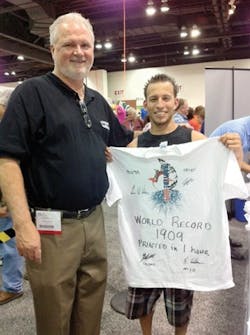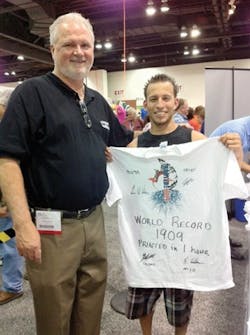Shirts Off to M&R for New World Record
M&R Printing Equipment (www.mrprint.com), a screen printing equipment manufacturer in Glen Ellyn, Illinois, beat its own world record last month, printing the most T-shirts in one hour by a single operator. Luis Omar Viera of New Buffalo Shirt Factory printed 1,909 shirts at the 2010 Imprinted Sportswear Show (ISS) in Fort Worth, Texas, flattening M&R’s previous record of 1,805 shirts.
The latest record used M&R's Challenger III, introduced in January, and its Passport Automatic Unloader. Challenger III is an automatic carousel textile press that features electronically driven print heads, pneumatic screen clamps, and a touchscreen control panel with icon-based labeling to simplify press operation.
Although much credit goes to Viera’s speed, precision and stamina (see http://www.youtube.com/mrprinting#p/u/0/MyPzDsg0QIg), the Challenger III is also M&R's fastest textile printer yet, and the belt servo indexing system—developed in cooperation with Mitsubishi Electric (www.mitsubishielectric.com) —works faster than a human can load the machine.
But to beat the world record for printing shirts, M&R had to speed up Challenger's print heads, according to Bo Biel, M&R's chief electrical engineer. Where previously the platform used ac drives and motors running at 2000 rpm, Challenger III uses integrated servo motors from Myostat Motion Control (www.myostat.ca). "The servo drive allowed us to more than double the speed of the printing head at 5,000 rpm, cutting down significantly the overall press’s cycle time," Biel says.
M&R’s oldest machines used pneumatic cylinders to drive the printing heads, Biel says. "Later we upgraded printing head control to ac drive and motor," he adds. "The next generation used ac drives with position control and ac motors with SKF sensor bearings for feedback."
The first servo drive used on the Challenger machines was a standard amplifier and servo motor. M&R tested multiple integrated servo products, and ultimately decided on Myostat's Cool Muscle servo. "Like with any development, it was about speed and performance," Biel says. He points to several features making the servo drive suitable for high-speed shirt printing, including a direct ac power input, HMI connectivity, Ethernet connectivity, the high-speed (6,000 rpm) servo motor and high-response drive, onboard motion control, high heat dissipation capability, and gateway functionality.
Also contributing to the speed of the textile press, says Biel, was a newly developed Pro-face (www.pro-face.com) 3.8 in. HMI with Modbus connectivity that M&R could use on its printing heads.


